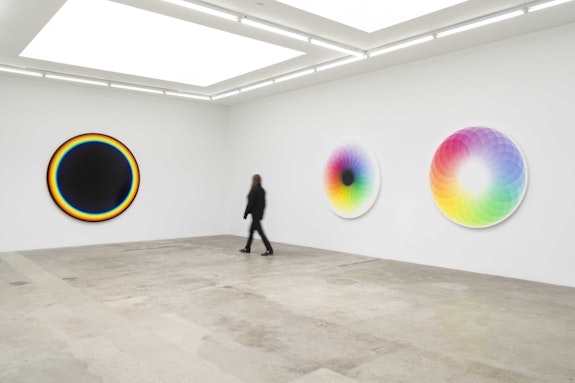ArtSeen
Olafur Eliasson: Your light spectrum and presence

On View
Tanya BonakdarFebruary 5 – April 2, 2022
Los Angeles
Olafur Eliasson’s most recent show at Tanya Bonakdar Gallery in Hollywood, California, Your light spectrum and presence, navigates through cerebral modulations of color that suggest the theatrical nuances of illusion. Each work acts like a portal, time capsule, or aperture of spectral phosphorescence. Acrylic paintings made with deliquesced, free-floating glacial ice stand as interfaces of climate awareness, while his “colour experiments” read as lambent orbits of light and darkness. Eliasson also investigates enigmatic color palettes associated with the rainbow as a form of interpreting ocular-centric perceptivity. Plato also gave prominence to sight, but in our world of multiple forms or legibility, is “seeing” truly believing?
Moving through the exhibition, oil works on canvas are suggestive of a trompe l'œil effect. At an immediate glance, the number of layers in each painting is not as apparent, however their complexity peels back like an onion, as if in a tripped-out experience. Eliasson’s black, rainbow-encircled, Colour experiment no. 101 (2020), scatters reflected light as an artificially synthesized plane. The mirror-like, oil-painted surface metaphorically esteems the self-indulgent gaze of the viewer, but also allows for a proprioceptive sensation through the viewer’s back-and-forth bodily movements. Eliasson is successful in communicating light in darkness, however, I question whether this body of work articulates darkness as the presence of copious color.

In Colour experiment no. 105 (2021), two oil-painted rainbow color wheels wrap around each other as rotating objects of light. The inner color wheel appears cone-like at its center with hues emanating from an internal focal point. To blend and create an ever-flowing bloom of color, filling every hue in between, purports a lesson in patience. Color preference is personal, and looking at this piece I find myself drawn to the innermost blue and green hues. Humans are thought to be evolutionarily predisposed to have a preference for colors associated with the natural world. This opens the question: what mechanisms, environments, or predeterminate factors define color preference?
The color palette of Colour experiment no. 108 (2020) is informed by photographs taken by Eliasson in Iceland. A piece of free-floating glacial ice from the Nuup Kangerlua fjord in Greenland, mixed with a minute amount of colorful pigments, melts onto the surface of the acrylic painting. The result is a washy puddle that appears to float above the surface. The work aims to be a commentary on humanity’s impact on the environment, a metaphor of the thawing of glaciers, which are creating a rise in sea level. Furthermore, this work suggests a visual ecological footprint. The unrecognized actor that is causing the ice to melt is mankind; as we don’t see the artist’s hand, it furthers the opacity of climate change, one that is not only imminent, but also irreparable—who makes the mark?
Eliasson finds significant inspiration in the Romantic masters J. M. W. Turner and Caspar David Friedrich. Friedrich’s Der Wandererüber dem Nebelmeer (The Wanderer above the Sea of Fog) (1818), is a reverent encapsulation of the sublimity of man confronting his precarious position in relation to the modern world; Eliasson’s piece also draws from the powerlessness of mankind within a world under his own fallacious control. Colour experiment no. 87 (2019), is a disc-shaped oil painting that investigates the aerial perspective and dematerialized landscape of Friedrich’s composition. A tangible circular gap in the middle of the piece reveals the crisp white gallery wall behind it. Is the exposed architecture part of the work, or is the work part of the architecture? As a unique piece within the exhibition, the work also pays homage to the stand-alone character depicted above the fog in Friedrich’s lionized painting.

In Light measurements: Reykjavik, 20 March 2011,13:00 GMT (2012), Eliasson records the changing frequency of light in the capital of his native Iceland. Each richly painted circular oil on canvas painting features a splash of rainbow emitted from a central oculus, surrounded by shifting streams of obscurely discernible dark tones. With an aim to capture wavelengths of light throughout the moving course of the day, Eliasson establishes a connection to the California Light and Space movement, specifically, James Turrell’s “Skyspace” works. While Turrell effectuates changing light patterns through optical phenomena, Eliasson transmutes light onto the canvas, in an attempt to capture its terrestrial inescapability.
Your light spectrum and presence exalts a passion for the ineluctable, primordial temporalities of human vision. Since the dawn of the industrial revolution, the potential insurmountability of climate change has been tied to the struggle of man versus nature. The idea that the manmade environment is separate from the natural world is misconstrued and ineffective. Solutions to climate change, if there are any, require mechanisms of accountability. Is there a light in the mist that can penetrate through the shame of our own inaction?

